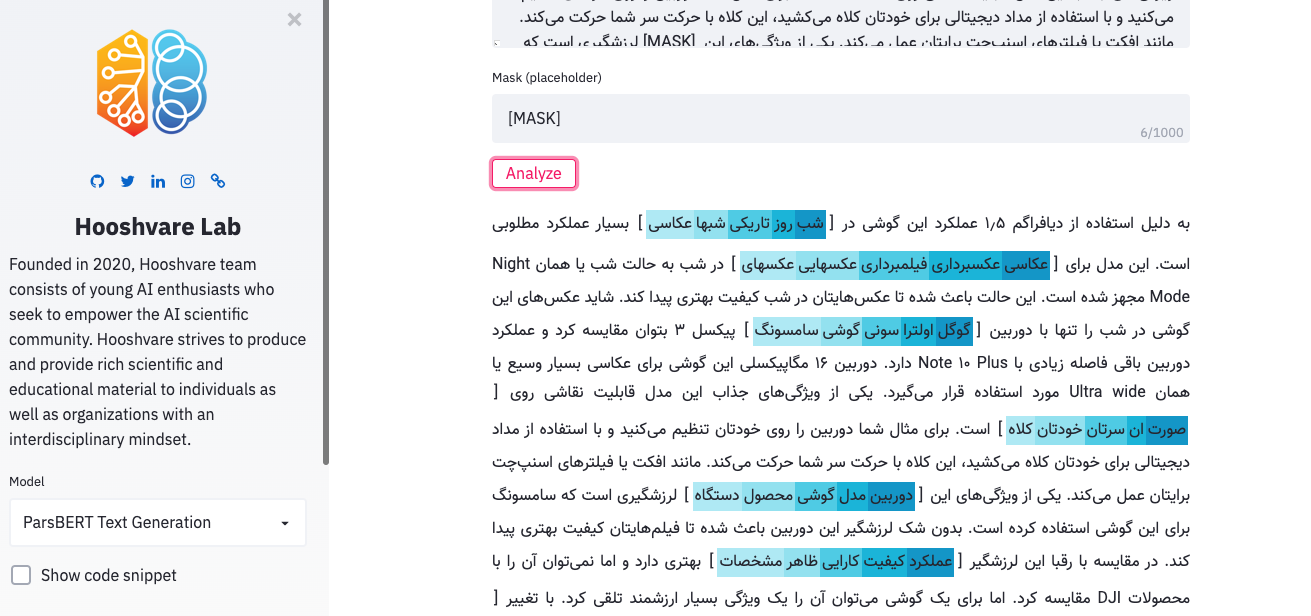Navigation Structure
Table of contents
- ParsBERT: Transformer-based Model for Persian Language Understanding
- Introduction
- Evaluation
- Results
- How to use
- NLP Tasks Tutorial
- Cite
- Acknowledgments
- Contributors
- Releases
ParsBERT: Transformer-based Model for Persian Language Understanding
ParsBERT is a monolingual language model based on Google’s BERT architecture. This model is pre-trained on large Persian corpora with various writing styles from numerous subjects (e.g., scientific, novels, news) with more than 3.9M documents, 73M sentences, and 1.3B words.
Paper presenting ParsBERT: arXiv:2005.12515
All the models (downstream tasks) are uncased and trained with whole word masking. (coming soon stay tuned)
Introduction
ParsBERT trained on a massive amount of public corpora (Persian Wikidumps, MirasText) and six other manually crawled text data from a various type of websites (BigBang Page scientific, Chetor lifestyle, Eligasht itinerary, Digikala digital magazine, Ted Talks general conversational, Books novels, storybooks, short stories from old to the contemporary era).
As a part of ParsBERT methodology, an extensive pre-processing combining POS tagging and WordPiece segmentation was carried out to bring the corpora into a proper format.
Evaluation
ParsBERT is evaluated on three NLP downstream tasks: Sentiment Analysis (SA), Text Classification, and Named Entity Recognition (NER). For this matter and due to insufficient resources, two large datasets for SA and two for text classification were manually composed, which are available for public use and benchmarking. ParsBERT outperformed all other language models, including multilingual BERT and other hybrid deep learning models for all tasks, improving the state-of-the-art performance in Persian language modeling.
Results
The following table summarizes the F1 score obtained by ParsBERT as compared to other models and architectures.
Sentiment Analysis (SA) task
| Dataset | ParsBERT | mBERT | DeepSentiPers |
|---|---|---|---|
| Digikala User Comments | 81.74* | 80.74 | - |
| SnappFood User Comments | 88.12* | 87.87 | - |
| SentiPers (Multi Class) | 71.11* | - | 69.33 |
| SentiPers (Binary Class) | 92.13* | - | 91.98 |
Text Classification (TC) task
| Dataset | ParsBERT | mBERT |
|---|---|---|
| Digikala Magazine | 93.59* | 90.72 |
| Persian News | 97.19* | 95.79 |
Named Entity Recognition (NER) task
| Dataset | ParsBERT | mBERT | MorphoBERT | Beheshti-NER | LSTM-CRF | Rule-Based CRF | BiLSTM-CRF |
|---|---|---|---|---|---|---|---|
| PEYMA | 93.10* | 86.64 | - | 90.59 | - | 84.00 | - |
| ARMAN | 98.79* | 95.89 | 89.9 | 84.03 | 86.55 | - | 77.45 |
If you tested ParsBERT on a public dataset and you want to add your results to the table above, open a pull request or contact us. Also make sure to have your code available online so we can add it as a reference
How to use
TensorFlow 2.0
from transformers import AutoConfig, AutoTokenizer, TFAutoModel
config = AutoConfig.from_pretrained("HooshvareLab/bert-base-parsbert-uncased")
tokenizer = AutoTokenizer.from_pretrained("HooshvareLab/bert-base-parsbert-uncased")
model = AutoModel.from_pretrained("HooshvareLab/bert-base-parsbert-uncased")
text = "ما در هوشواره معتقدیم با انتقال صحیح دانش و آگاهی، همه افراد میتوانند از ابزارهای هوشمند استفاده کنند. شعار ما هوش مصنوعی برای همه است."
tokenizer.tokenize(text)
>>> ['ما', 'در', 'هوش', '##واره', 'معتقدیم', 'با', 'انتقال', 'صحیح', 'دانش', 'و', 'اگاهی', '،', 'همه', 'افراد', 'میتوانند', 'از', 'ابزارهای', 'هوشمند', 'استفاده', 'کنند', '.', 'شعار', 'ما', 'هوش', 'مصنوعی', 'برای', 'همه', 'است', '.']
Pytorch
from transformers import AutoConfig, AutoTokenizer, AutoModel
config = AutoConfig.from_pretrained("HooshvareLab/bert-base-parsbert-uncased")
tokenizer = AutoTokenizer.from_pretrained("HooshvareLab/bert-base-parsbert-uncased")
model = AutoModel.from_pretrained("HooshvareLab/bert-base-parsbert-uncased")
NLP Tasks Tutorial
- Named Entity Recognition
- Sentiment (soon).
- Text Classification (soon).
- Topic modeling (soon).
- Question Answering (soon).
Cite
Please cite the following paper in your publication if you are using ParsBERT in your research:
@article{ParsBERT,
title={ParsBERT: Transformer-based Model for Persian Language Understanding},
author={Mehrdad Farahani, Mohammad Gharachorloo, Marzieh Farahani, Mohammad Manthouri},
journal={ArXiv},
year={2020},
volume={abs/2005.12515}
}
Acknowledgments
We hereby, express our gratitude to the Tensorflow Research Cloud (TFRC) program for providing us with the necessary computation resources. We also thank Hooshvare Research Group for facilitating dataset gathering and scraping online text resources.
Contributors
- Mehrdad Farahani: Linkedin, Twitter, Github
- Mohammad Gharachorloo: Linkedin, Twitter, Github
- Marzieh Farahani: Linkedin, Twitter, Github
- Mohammad Manthouri: Linkedin, Twitter, Github
- Hooshvare Team: Official Website, Linkedin, Twitter, Github, Instagram
Releases
Release v0.1 (May 27, 2019)
This is the first version of our ParsBERT based on BERTBASE
